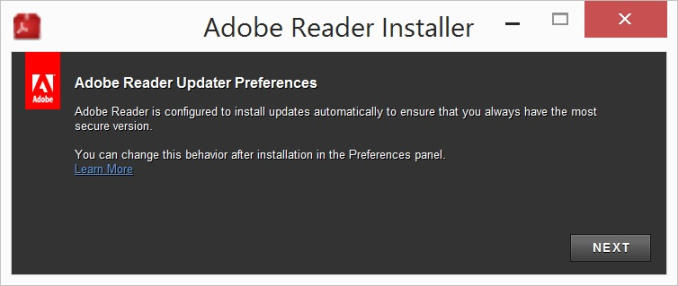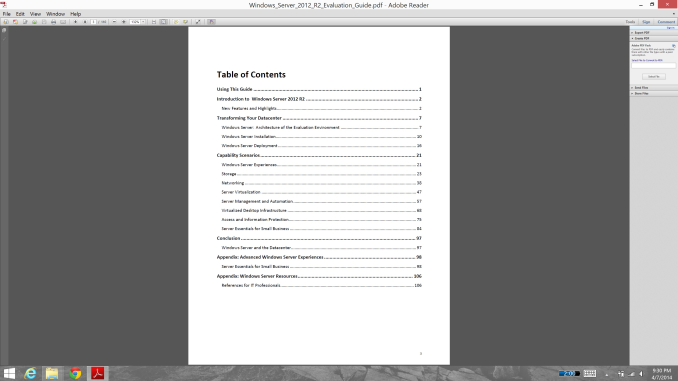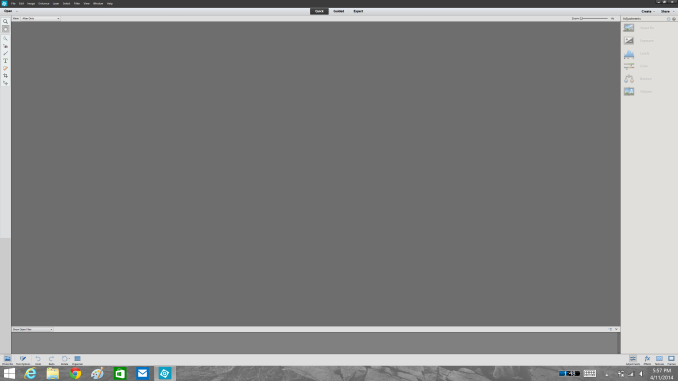Scaling Windows - The DPI Arms Race
by Brett Howse on April 15, 2014 2:00 PM EST- Posted in
- Operating Systems
- Windows
- Microsoft
- Windows 8.1
- High DPI
When It All Goes Really Wrong
As we’ve seen, Windows can use DPI Virtualization to correct applications that are DPI-unaware, and applications that choose to can opt out of the scaling features and perform their own. But so far we’ve really only seen applications that are slightly out of sync with the developer’s goal. Now it’s time to show some applications that are well and truly broken on High DPI systems.
There are more than this small selection, but the examples I have are all from Adobe. Adobe tends to write its own user interface, which it then can make cross platform. Unlike most applications that use at least some standard Windows tools like Windows Presentation Foundation (WPF) or Windows Forms, almost the entire UI is created by Adobe. As you can imagine, the results are not pretty at 3200x1800 and 200% scaling. First up – the Adobe downloader.
Adobe really wants you to know you are using their product. Even something as simple as an application to download Adobe Reader has its own custom UI. The text box is generally fine, but it's a bit difficult to read. Next is a commonly used application, Adobe Reader XI
Here the file menu is usable, but all of the shortcut icons are tiny. The Tools, Sign, and Comment panels are so small as to be practically unusable. It’s not pretty, and applications like this are a big reason why High DPI Windows systems get knocked during reviews. And our final call out of Adobe’s applications – Photoshop Elements
This application is the worst example of usability on a High DPI system that I’ve seen. Adobe has even replaced the file menu with a custom UI, meaning every single element of this application doesn’t scale at all.
The biggest travesty of Adobe applications not scaling is that their intended market is often media professionals, who are frequently early adopters of things like 4k displays and ultra-high resolution laptops. Hopefully they are working hard on a solution to these issues, but that will also mean anyone using Adobe’s products will likely be forced to update to the latest version – a potentially expensive proposition.
It may seem unfair to specifically call out Adobe, so be aware that there are other applications that also struggle. Remote Desktop sessions can be an issue, with the RDP session rendering at the DPI level of the server, but the resolution of the client. Luckily this has been addressed in the latest versions, but doing RDP sessions or RemoteApp connections to older versions of Windows Server may still be an issue. There are games that likewise have their own launchers that are fully custom and have no scaling (StarCraft II comes to mind), so they end up looking very small on a High DPI system.













114 Comments
View All Comments
Taracta - Friday, April 18, 2014 - link
I could say the IBM started the high density displays with the T220/T221 4K 22" monitors in 2001 with a ~200 DPI but I won't because these were not followed up on like the Sony laptop display you mentioned. I believe that it only counts when you follow up on it and make it part of your product portfolio, which is what Apple did, which forced the others to do it too.So I give credit to Apple and not IBM, for them mainstreaming HiDPI by requesting HiDPI panels from their ODMs suppliers. This in turn allowed the others to have access to the technology but Apple was the leader in mainstreaming it.
Gigaplex - Wednesday, April 16, 2014 - link
Apple didn't make the panels, they bought them off suppliers that were making them anyway. Often those panel suppliers were also Android manufacturers, so don't try to tell us that those screens wouldn't have made it to Android without Apple.yasamoka - Wednesday, April 16, 2014 - link
Hint, those displays were MADE for Apple. Upon Apple's request. Nobody cares who made the displays, they didn't appear out of thin air and then Apple went: OH PERFECT, this is a perfect fit!psyq321 - Thursday, April 17, 2014 - link
Sony introduced a 4" 1024x600 display (296 PPI) in 2007 --> look up Sony Vaio UXSony also introduced a 13" 1920x1080 display (170 PPI) in 2010 --> look up Sony Vaio VPC-Z
So, no, Apple did not invent high DPI screens. Apple invented a marketing name for them ("Retina"), though.
By the way, Apple's notebook displays were low-DPI garbage before Retina Macbook Pro. I switched to Retina Macbook Pro since Sony stopped innovating and retired Vaio Z and Apple finally decided to produce a real high-end notebook. I could not even think of this before Apple decided to put a decent resolution display in their notebook.
psyq321 - Thursday, April 17, 2014 - link
Before I switched to 15" Retina Macbook Pro, I had all generations of Sony Vaio Z.Sony switched to 13" Full HD panels in 2010. Two years before Apple's switch to "retina" screens in their laptops. Before Apple Retina Macbook Pro, the DPI of their notebooks was pathetic.
Also, Sony had Vaio UX with 1024x600 4" screen in 2007.
munim - Tuesday, April 15, 2014 - link
These problems are why I won't be upgrading from my 96 DPI 24 inch monitor for the foreseeable future.jhoff80 - Tuesday, April 15, 2014 - link
"The Surface Pro’s on-device screen is set at 200% scaling which is necessary to make that resolution work on a 10” screen"No, it isn't. Out of the box, the Surface Pro and Surface Pro 2 are set to 150% scaling on their own displays. And for what it's worth, 125% scaling is completely usable as well - I've used it that way since release of the Pro 1 (since upgraded to the Pro 2).
bountygiver - Tuesday, April 15, 2014 - link
Exactly, even with only 125%, I have no problem navigating most legacy applications with touch.Brett Howse - Tuesday, April 15, 2014 - link
Sorry about that - fixed now.darthrevan13 - Tuesday, April 15, 2014 - link
"Few high resolution devices"? That's no excuse! You can move the slider up to 150-200% even on your current low res display and then things will have to get 1.5-2 times bigger. It's not hard at all! I am a developer and I can't understand that. Microsoft released the API for this at the start of 2007, that makes 6 years not including this one.Most of all Adobe has no excuse at all! They should offer all of their next version apps which scale correctly for free!